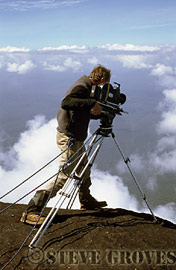|
THE STORY
The first thing one notices is that
Roraima, like other Tepuis, is a botanical paradise; almost every plant
you see on Roraima is only known from this one bleak mountain top. Among
the rocky labyrinths, areas of flat rock and boggy depressions, there
is little to cling to, except shallow soil or tiny rock crevices. It's
a harsh environment where temperatures can soar and then drop to freezing,
and where sudden storms bring fierce winds and flash floods. Yet there
are many fragile and beautiful species of plant that seem to thrive, some
of them bearing flamboyant, colourful flowers.
|
|
|
|
|
Stegolepis
guianensis
|
Plant
community
|
Heliamphora
nutans
|
The plants of Roraima are specialists in the art
of survival. In order to cope with nutrient poor soils, carnivorous plants
like sundews, bladderworts, pitcher plants, and even a bromeliad species
all supplement their diet by trapping and digesting insects. Other species
have developed thick waxy leaves to help retain water when temperatures
soar. Orchids, so successful in colonizing such environments, are plentiful
here, with flowers ranging from large and showy, down to the size of a
pin head.
Crossing the summit of Roraima is not an easy task.
Between me and the northern prow were several miles of cliffs, loose rock,
and deep canyons, but I wanted to satisfy a twenty nine year old challenge.
Walking across the ancient sandstone, one can see the process of erosion
that formed this place in action. In places, layers of sedimentary sandstone
have worn away, exposing fossil ripple marks, suggesting that the summit
of Roraima was perhaps, back in Precambrian times, the bed of a shallow
lake. Everywhere, rain water collects in deep pools, its course channelled
along furrows, the embryos of deeper crevices, cracks and canyons that
form a complex network of barriers hampering progress on foot in any direction.
Some of the sedimentary layers of sandstone are softer than others, and
it is these that have eroded more quickly, producing amazing rock shapes,
and exposing layers of quartz crystals.
 |
My route led me due north through
the labyrinths of rocks; following the course of streams of water
stained golden by plant tannins; across bleak, windswept areas of
flat rock where the delicate pink colour of the sandstone has been
blackened by a coating of surface algae and fungi; across wide gullies
filled with other worldly plants; until, finally, only a few rocky
crevices separated me from my goal. Finally, just a few more steps
would take me to the very tip of Roraima's prow. It commands an
extraordinary view, looking north across hundreds of miles of unbroken
forest in Guyana. Looking vertically down I could see the ridge
we had climbed thirty years before. It reminded me of the thrill
of my first experience in a place where no human had been before.
It also reminded me of some of the scientific discoveries of that
first expedition.
Adrian
Warren filming from the Prow of RORAIMA
|
|